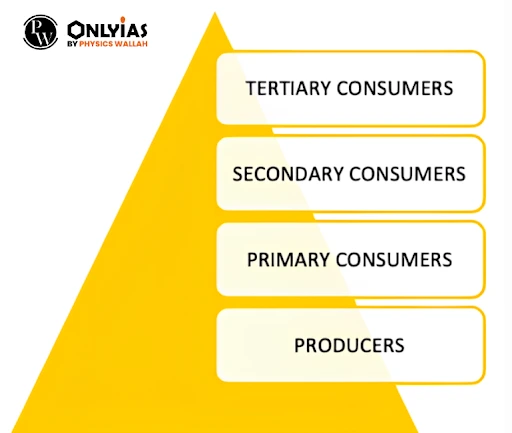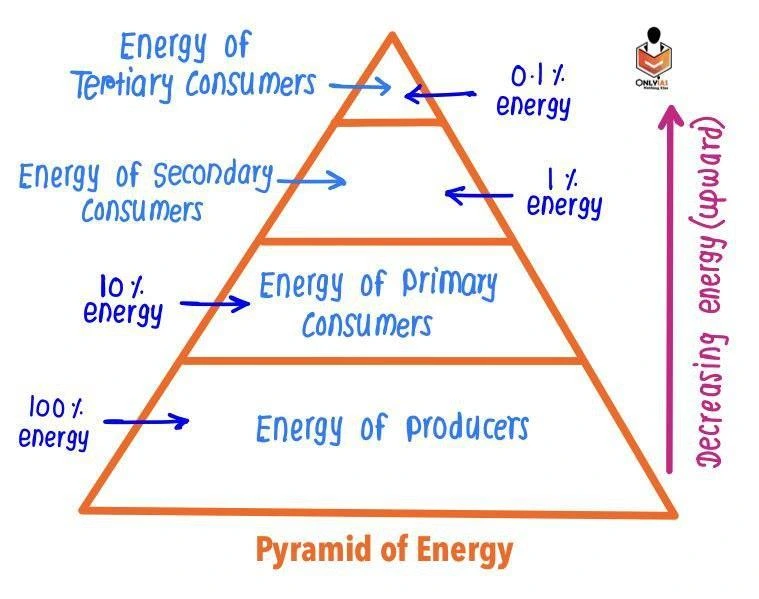|
Ecological Pyramids: Trophic Levels, Types & Energy Dynamics in Ecosystems |
Ecological Pyramids: Charles Elton’s Innovative Concept
Ecological pyramids are graphical representations used in ecology to illustrate the relationships between different trophic levels within an ecosystem. Charles Elton, a leading British ecologist, was the one to originally present the idea of an ecological pyramid.
Ecological Pyramid: Visualizing Ecosystem Interactions
- An ecological pyramid is a representation of trophic levels through horizontal bars that illustrates the interconnection among various organisms within an ecosystem, showcasing their roles and interactions.
- Horizontal Bars: It has a number of horizontal bars representing specific trophic levels which are arranged sequentially from producer to top level consumers.
- The length of each horizontal bar represents the overall population of each trophic level in an ecosystem.
- Graphical Depiction: It is a graphical depiction of how various ecological creatures relate to one another.
Ecological Pyramid: Trophic Levels in Ecosystem Hierarchy
- Trophic level is a hierarchical level within an ecosystem that represents an organism’s position in the food chain or food web.
- Trophic levels help describe the flow of energy and nutrients through an ecosystem and the interactions between different species.
- Different Types of Trophic Levels:
- Producers: An ecological pyramid’s base is widest, and it contains the producers. They form the first trophic level.
- Primary consumers: Just as in a food chain, in the ecological pyramid also, primary consumers occupy the next level because primary consumers consume producers.
- Secondary consumers: Similarly, secondary consumers occupy the third level.
- Tertiary customers: The organisms that eat the secondary consumers.
Types and Insights of Ecological Pyramids
- Pyramid of numbers.
- Pyramid of biomass.
- Pyramid of energy.
- Pyramid of Number
- The proportional number of creatures at each level of a food chain is represented as a pyramid of numbers.
- Depending on the ecology, number pyramids can be either upright or inverted.
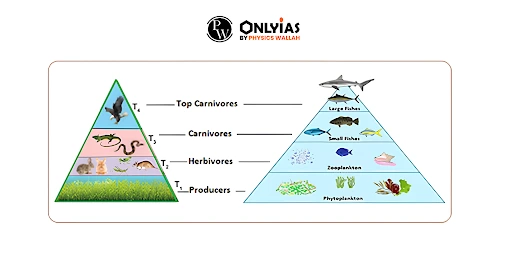
- Pyramid of Numbers: Upright
- Grassland ecosystem: The typical grassland has an upright shape as it has a base of many plants, with the numbers of organisms decreasing at each trophic level.
- Pond ecosystem: In a pond ecosystem, the pyramid of numbers is upright.
- The primary producers, primarily comprising phytoplankton like algae and bacteria, outnumber the herbivores, which include smaller organisms like fish and rotifers.
- Moving up the trophic levels, the secondary consumers, like smaller fish preying on one another and water beetles, exhibit a lower population count than the herbivores.
- Lastly, at the apex, the tertiary consumers, represented by larger fish, are present in the smallest numbers.
- Pyramid of Numbers: Inverted
- A pyramid of numbers does not always have a regular pyramid shape as it does not take into account the biomass of the organisms.
- In an ecosystem, when a very few big biomass producers sustain a greater number of smaller consumers, an inverted pyramid of numbers can be observed.
- In a tree-based ecosystem, the number pyramid assumes an inverted shape because the initial trophic level, represented by the trees, is the least abundant within the ecosystem.
- An inverted pyramid of numbers can also occur in an ecosystem where the community contains parasites.
- In this pyramid, the number of individuals at each level rises from the lowest to the highest.
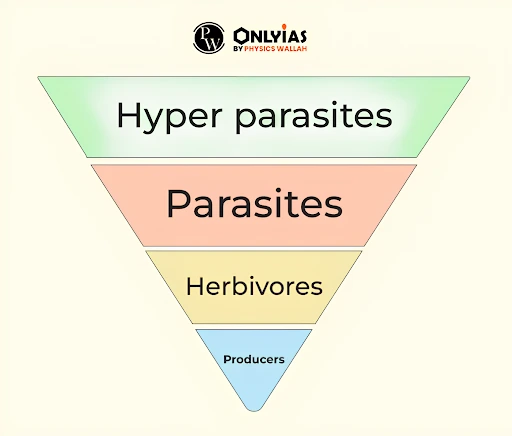
-
- In these food chains, a single producer typically supports a large number of parasites.
- More hyper-parasites are supported by the parasites in turn.
- Pyramid of Biomass in Terrestrial Ecosystems: Upright
- The pyramid of biomass represents the total mass of organisms at each trophic level.
- Usually, this type of pyramid is larger at the bottom and gets smaller going up.
- Pyramid of Biomass (Upright):
- Terrestrial ecosystems: Biomass pyramid for the majority of terrestrial ecosystems includes a big base of primary producers and a smaller trophic level on top of it.
- Producers:The biomass of producers like autotrophs is at its highest level.
- Primary consumers: Biomass of the primary consumers at the following trophic level is lower than that of the producers.
- Secondary consumers: They have lower biomass than primary consumers.
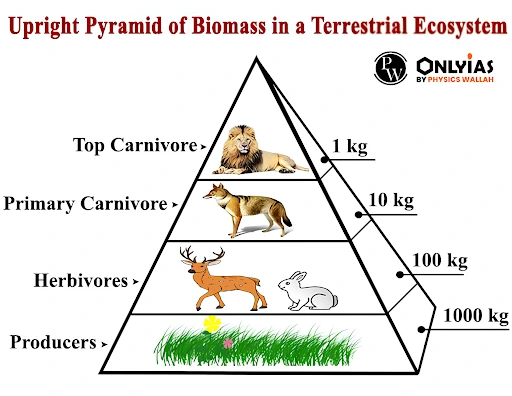
- Pyramid of Biomass (Inverted):
- Aquatic Ecosystem: The pyramid of biomass in sea is generally inverted because the biomass of fishes far exceeds that of phytoplankton.
- Inverted Shape: The pyramid of biomass has a small base, with the consumer biomass at any instant exceeding the producer biomass and the pyramid assumes an inverted shape.
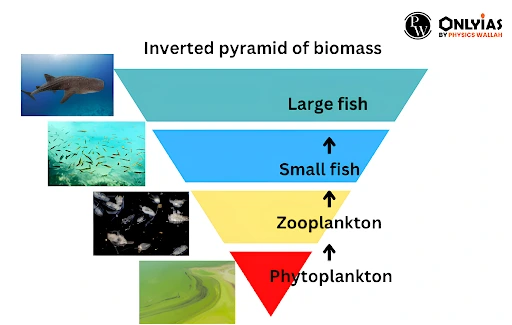
- Pyramid of Energy: Always Upright and the 10% Rule
- About: A pyramid of energy represents the amount of energy trapped per area in a given time period at each stage of a food chain.
- Always Upright: These pyramids are always upright in shape, as energy is lost along food chains which is either used in respiration or lost as heat.
- 10% Llaw: Each level in the pyramid will be approximately one tenth the size of the preceding level as energy transformations are ~10% efficient.
- Law of Thermodynamics: The “Law of Thermodynamics” is reflected by an energy pyramid.
- It shows how solar energy is converted into chemical and thermal energy at each trophic level and how energy is lost at each transfer to a higher level.
Limitations of Ecological Pyramids: Simplifications and Omissions
- It does not take into account the same species belonging to two or more trophic levels.
- Saprophytes such as plants, fungus, or microorganisms that live on decaying matter are not given any place in ecological pyramids even though they play a vital role in the ecosystem.
- It relies on a straightforward simple food chain, a scenario rarely found in nature, and does not take account of a complex food web.
Ecological Pyramid: Conclusion
- Ecological pyramids are valuable tools in ecology for visualizing and understanding the energy flow, biomass, and population structure within ecosystems.
These ecological pyramids highlight the hierarchical nature of trophic levels, revealing the interdependence of species and the importance of energy efficiency in ecological systems.
























